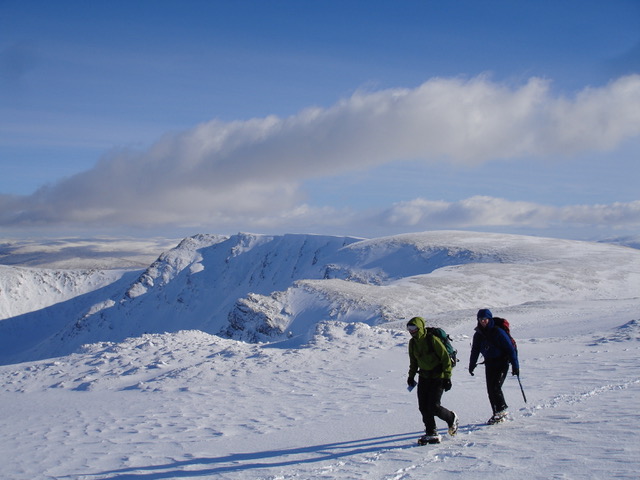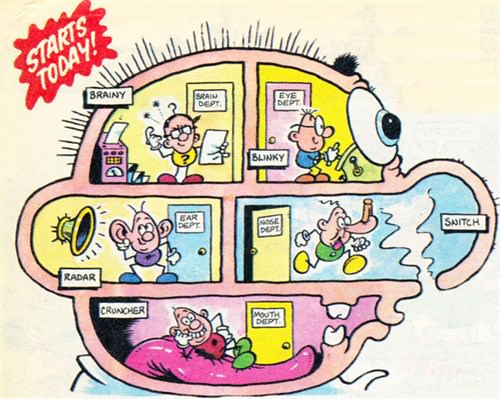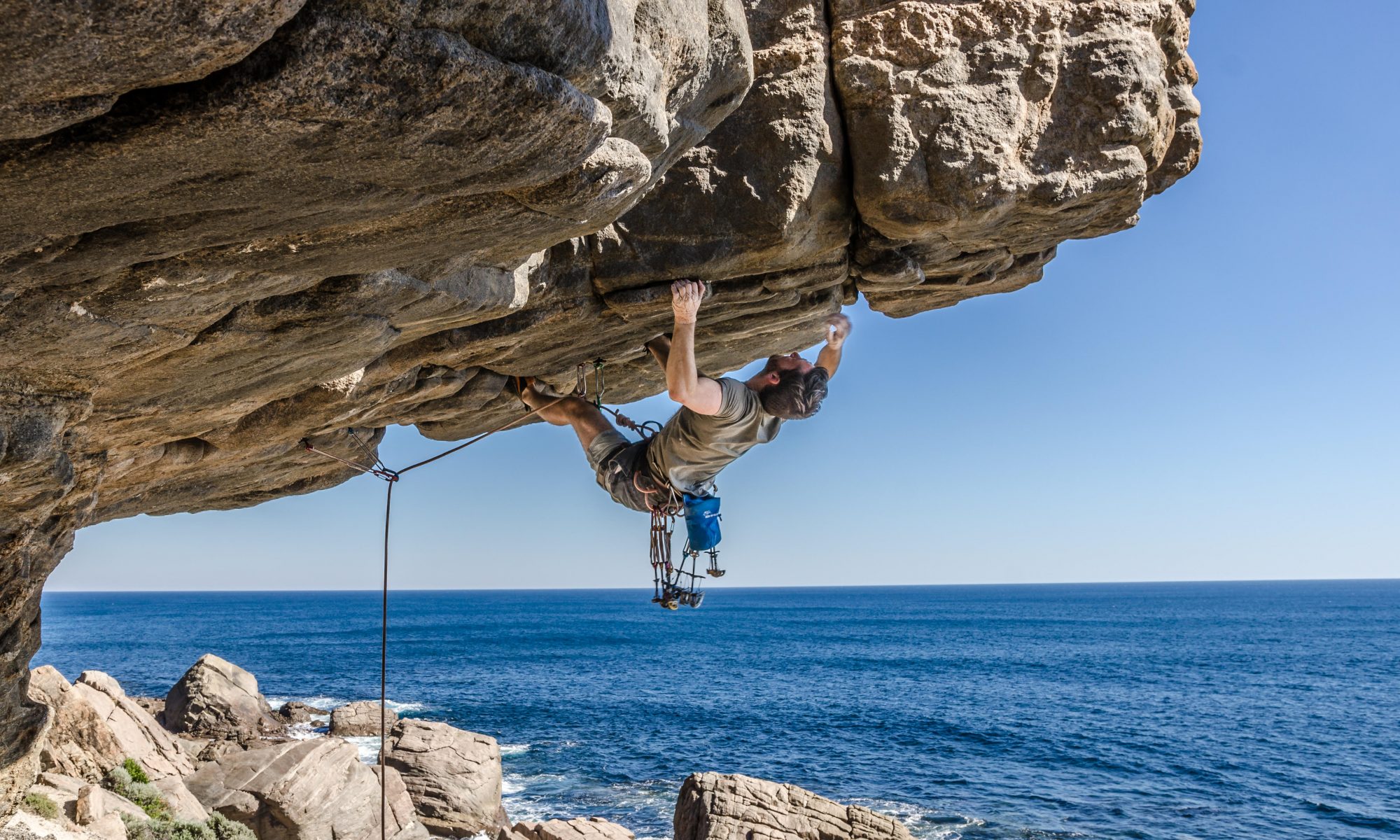Fluid dynamics, weather systems and coaching adventure sports

Rolling clouds over a snow-capped Craig Megaidth. Moving skillfully and making decisions on a Winter ML Assessment. Photo by Olly Sanders
Adventure sports coaches typically support individuals to operate confidently and competently in changeable and complex environments. To do this it would help to understand how people learn to interpret their environment, make decisions and move skillfully.
An ecological dynamics (ED) theory approach to coaching and learning views human movement as an interaction between the individual, the activity and the environment in which the activity is taking place. This approach emerged from the application of dynamical systems theory and ecological psychology6 to motor learning and is the underpinning theory for the ‘constraints’ led approach to the way we structure practice. All of you who coach or participate in adventure sports will be familiar with aspects of this approach already. You will intuitively recognise and understand it even if you have not used it to understand movement and learning. This is a brief introduction to the concepts and theories behind an ED approach to coaching and learning. In the following articles, armed with this understanding, we can look at the implications that this approach has for coaching adventure sports.
Understanding Learning
Do we need theories in order to provide a framework for understanding learning? Unfortunately, we can’t just open up a human and have a good look inside! So, we have to guess. And then rigorously test our guesses to see how accurate and useful they are. The theories we then use will inform our expectations, our decision making as coaches and our coaching behaviour.
Traditionally coaching practice has used motor programming or information processing theories7 to describe and understand how we learn to move skillfully. The main reason for this is that the basic concepts and the language used are more established in our coaching literature and behaviour, and in our education systems. Because of this, many coaches will be more familiar with the ‘information processing’ approach and find it easier to understand.
What is ‘information processing’ theory?
In very simplistic terms information processing theory attempts to understand how we move and how we learn by using computer programming analogies. This is based on how computers process information. There is an input, various programmes (usually shown as boxes), and an output. The more complex the movement, the more boxes! The programmes do things like recognise, organise, initiate, carry out, and monitor intended actions; for example:
| Stimulus
INPUT |
Stimulus Identification | Response
Selection |
Response Programming | Movement
OUTPUT |
An example information processing model for the Human7
Whilst this approach is appealingly simple it does have a number of problems. These include; limited storage space (for all those programmes and all those boxes), slow reaction times, top-down control, no account of movement variability, no account of non-linear behaviour, the ‘degrees of freedom’ problem (too many variables to individually control), no link to performance environments or perceptual information, and issues with how the programmes are programmed in the first place.
If we assume that we all agree that God didn’t write the programmes and we don’t have Numskulls living in our heads (for those old enough to remember them from the Beano), then we have a problem. This is known as the problem of infinite regress, or, if the Numskulls are controlling Edd’s head who’s controlling the Numskulls?

The Numskulls: There’s a lot going on in Edd’s head!
Another potential problem is that the variables are usually depicted as having sequential, linear relationships making it easy to design simple experiments to test them (i.e. variable A: causes, moderates or mediates variable B:). The research and experiments are also usually conducted in laboratory settings using very simple movements. The guiding assumption is that to truly understand a relationship you need to strip away everything else that could possibly influence it and test it in isolation. Then you need to assume that when it is put it back in the whole (a complex movement in a dynamic and complex environment), the relationship between the variables stays the same.
This is a bit like viewing us, and how we move and interact, as though we were mechanical clocks. If you dismantle a clock and look at the various components in isolation, they still behave the same way as they did when it was a whole clock. But we can’t do that with people, and we know that it would not work as a mechanical clock if we could.
Learning a new language
I remember being introduced to dynamical systems theory and ecological psychology in my undergraduate motor control lectures in the early ’90s and thinking that someone had just switched a light on for the first time. The concepts made so much sense; they were fascinating, exciting, intuitively simple, and reflected everything I saw in the natural world around me. However, as I started trying to conduct my research in motor learning I found myself entangled in a hugely complex theoretical and mathematical web and having to learn what felt like a whole new language. There was lots of research looking at how we physically moved and how we perceived our environment, however, at that time most researchers were still using motor programming theories to understand how we learnt new movements. The emergence of the ED and the constraints-led approach as a coherent framework for understanding skill acquisition has been a huge boon to those of us who coach and design learning contexts.
Where do fluid dynamics and weather systems come into all of this?
‘Dynamical systems’ is a mathematical theory of complex systems (like people, not mechanical clocks). It emerged in the 1970s from the work of brilliant scientists like Edward Lorenz researching in the fields of long-term weather forecasting, and from researchers looking at the pesky problem of turbulence in fluid dynamics5. Weather and our waters do not behave like mechanical clocks; there is complexity and disorder in the atmosphere, in the turbulent seas and raging rivers. Knowing the relationship between two components in isolation doesn’t necessarily predict how they will behave in the system as a whole. Tiny differences in initial conditions could dramatically change the behaviour of a whole system over time. This is where the term ‘the butterfly effect’ came from and the concept of ‘chaos’. Complex systems are not sequential or linear. And they don’t require ‘programmes’. But there is order in the disorder, and there are patterns and predictability in the chaos and we can use these to help us understand movement, coaching and learning.
Properties of complex systems
Two of the key properties of a complex system are that they are non-linear and self-organising. To understand these basic concepts, let’s look at how water behaves. When it rains heavily and your favourite river or mountain stream starts to rise, does it just become a proportionally faster and bigger version of what it was in low water? Of course not. Features appear, fluctuate, mutate, and disappear again. However, the features on the River Tryweryn will be recognisable at specific cumecs of dam release (all other constraints being equal), and high tide hole on the Menai Strait will form during predictable tidal heights and directions. There is no programme to specify when and how the features change, when a riffle becomes an eddy, or a wave, or a hole; they ‘self-organise’ within the constraints of the environment. Features form and emerge spontaneously due to the properties of the water molecules, the shape of the river bed, obstacles, water volume, atmospheric pressure, and any other contributing factor or constraint. A feature that is stable, even if only briefly, is known as an ‘attractor state’. As the constraints change, for example, water volume; the attractor states will become unstable before settling into new attractor states, or becoming chaotic.
River features are generally quite unstable attractor states. However, when water changes temperature, it also follows non-linear dynamics. At a definable temperature it will evaporate and become steam, and a mountain stream will freeze and become climbable when cold enough. Most experienced mountaineers understand the constraints that are needed to make the conditions right for ice climbing. Ice is a more stable attractor state than a river eddy, but will still become unstable as it goes through a ‘phase change’ and melts to become water again. Precipitation will fall as snow instead of rain under different constraints.
Rivers change with the water levels, forming and reforming stable features, or attractor states, amongst the chaos. Dan Butler using the river features with finesse and nailing a boof on the Soana River, Val Aosta. Photo by Richard Watson
How can we compare the behaviour of water and rivers to human movement?
A simple example that illustrates non-linear dynamics in movement is how our gait changes when we move at different speeds. When a child walks faster a point is reached when the walking gait becomes less efficient and unstable and the child will spontaneously start to run. A horse with no rider to influence it will not simply walk faster and faster as it increases speed. A point will be reached within each gait when it becomes unstable and inefficient and the horse will ‘break’ into a different gait. Just like the river, there is a non-linear relationship between speed and movement pattern that is the result of the constraints of the system. The constraints of a movement system are the properties of things like the bones, joints, tendons, muscles, intentions and goals, motivation, skill level, and the supporting biological and neural systems. An increase in effort is required to override the spontaneous self-organisation of the gaits.
Another good example you will all be familiar with is the coupling of our limbs. They are ‘coupled’ or ‘constrained’ by neural and biomechanical properties to reduce the degrees of freedom available in our movement repertoire. This is evident when you try to uncouple them – like uncoupling your arms to pat your head and rub circles on your tummy at the same time. Or doing jumping jacks, and then changing the sequence of legs and arms to take them ‘out of phase’. Uncoupling or using your limbs out of phase is more effortful and requires learning. If you speed up your ‘out of phase’ movements enough (unless well learnt) they will start to become unstable and then spontaneously go back ‘into phase’. In phase and out of phase are not different motor programmes but the result of self-organisation of our movement system.
A familiar psychological example is the ‘catastrophe curve’ theory of the ‘stress and performance’ relationship3. The catastrophe curve predicts that performance will increase with increases in arousal levels (stress) up to a point, then it will start to drop. However, at some point, it starts to become unstable and will eventually drop off dramatically. Once this happens, you have to significantly reduce arousal levels to get back onto the performance curve again. There are many of us who have tipped over this point, some never getting back on.
The problem with humans; perception, intention and free will!
The concept of direct perception was proposed by James Gibson in the 1970’s4. He suggested that it didn’t make sense for us to have a ‘programme’ to translate perceptual stimuli like that received by the optic nerves in our eyes. Instead, he proposed that we have evolved over time to directly perceive the meaningful information in our environment. We have evolved to detect the information that matters to our survival whether that is finding food, avoiding danger, finding shelter, comfort, or a mate. This is why we don’t see the same information in the environment as a bat or a shark. We don’t hear the same range of sounds as a mouse or an elephant. We are, as a species, attuned to the information in the environment that is meaningful to us and that affords movement and survival.

Well-honed perception-action coupling. Sam Davies skillfully reading the rock on KGB, Willyabrup, WA. Photo by Siu On
This concept of direct perception and affordance means that we have perception-action coupling. This perception-action coupling is strengthened through learning and becoming more attuned to information available to us that is relevant for movement2. A complete beginner looking at a section of a river will be looking at the same piece of water as an experienced paddler, but the experienced paddler will be seeing patterns and affordances in the water features that mean something to them in terms of movement choices that they can make. The beginner will probably be seeing a seething mass of random ‘noise’ that is complex, meaningless and even frightening.
The same principle applies to an experienced climber, skier or any other adventure sports participant. An experienced climber will see patterns and affordances in the rock features that are meaningless to a beginner. These affordances also change with movement. This suggests that skills that will be executed within a specific environment and linked to perceptual information should be learnt and practised in that environment.
As humans, our behaviour is obviously not just shaped by our environment and our genetic evolution. We have free will, we think, we choose to do things. We have past experiences and pre-conceptions, motivation, inspiration, or lack of interest. These psychological and cognitive factors, whilst creating more complexity for coaches to think about, form some of the individual (organismic) constraints in skill acquisition1. It is worth noting that an ED approach does not have a clear and testable explanation of internal representation, cognition or emotion (yet). It does, however, allow us to get rid of some of the black boxes (and the Numskulls). Other individual constraints include things that are easier to measure, like fitness, body size and shape, right or left-handedness, injuries, and technical abilities.
What does all this mean to us as coaches?
As a coach, it is worth thinking about the implications of learning being about developing perception-action coupling. What are the implications of the authenticity of the practice, or learning environment? Does it contain the same perceptual information as the performance environment? When viewed as an interaction between the individual, the task (or skill), and the environment, how important is it that information (perceptual) and outcome are focused on in coaching rather than movement form. What would this mean in terms of designing learning programmes and practice schedules? What are the implications of ‘perception-action coupling’, ‘self-organisation’, ‘attractor states’, and ‘instability’ existing in movement, skill acquisition and performance? We will expand on these concepts in the following articles and explore how we can use an ED approach practically in our coaching practice.

Marianne on one of her horses ‘River Tiger’ exploring the horse-human complex system.
About the author
Marianne’s practical experience includes more than 20 years of coaching and 8 years as a coaching manager, coach educator & assessor. This is complemented with a passion for participating in most adventure sports and many years as an active Mountain Rescue team member, giving an insight into diverse aspects of performance in the outdoors. Her main interests are climbing, paddlesports and equestrian activities. Marianne is currently doing a PhD (Developing an ecological dynamics model of skill acquisition for equestrian sports coaching) at Hartpury University. Marianne has an MRes. (Distinction) Sport & Exercise Science (Motivation & Skill Acquisition and a BSc (Hons), Sport, Health and Physical Education.
marianne@dynamics-coaching.com Copyright remains with the author
References:
- Brymer, E. & Renshaw, I. (2010). An introduction to the constraints-led approach to learning in outdoor education, Australian Journal of Outdoor Education, 14(2), pp 33-41.
- Davids, Button & Bennett (2008). Dynamics of Skill Acquisition; A Constraints-led Approach, Kinetics.
- Hardy, L and Fazey, J. (1987). The inverted-u hypothesis: a catastrophe for sport psychology and a statement of a new hypothesis. In Jones, G. and Hardy, L (1990), Stress and performance in sport, Wiley and Sons Ltd.
- Gibson, J. J. (1979). The Ecological Approach to Visual Perception. Hillside, HJ: Erlbaum.
- Gleick, J. (1988), Chaos: The amazing science of the unpredictable, Minerva.
- Renshaw, I., Davids, K., and Savelsbergh, G. J. P, (Eds.) (2011) Motor learning in practice; A constrains-led approach. Routledge.
- Schmidt, R. A., (1988). Motor control and Learning; A behavioural emphasis (2nd Ed). Human Kinetics.
Discover more from Dynamics Coaching
Subscribe to get the latest posts sent to your email.

